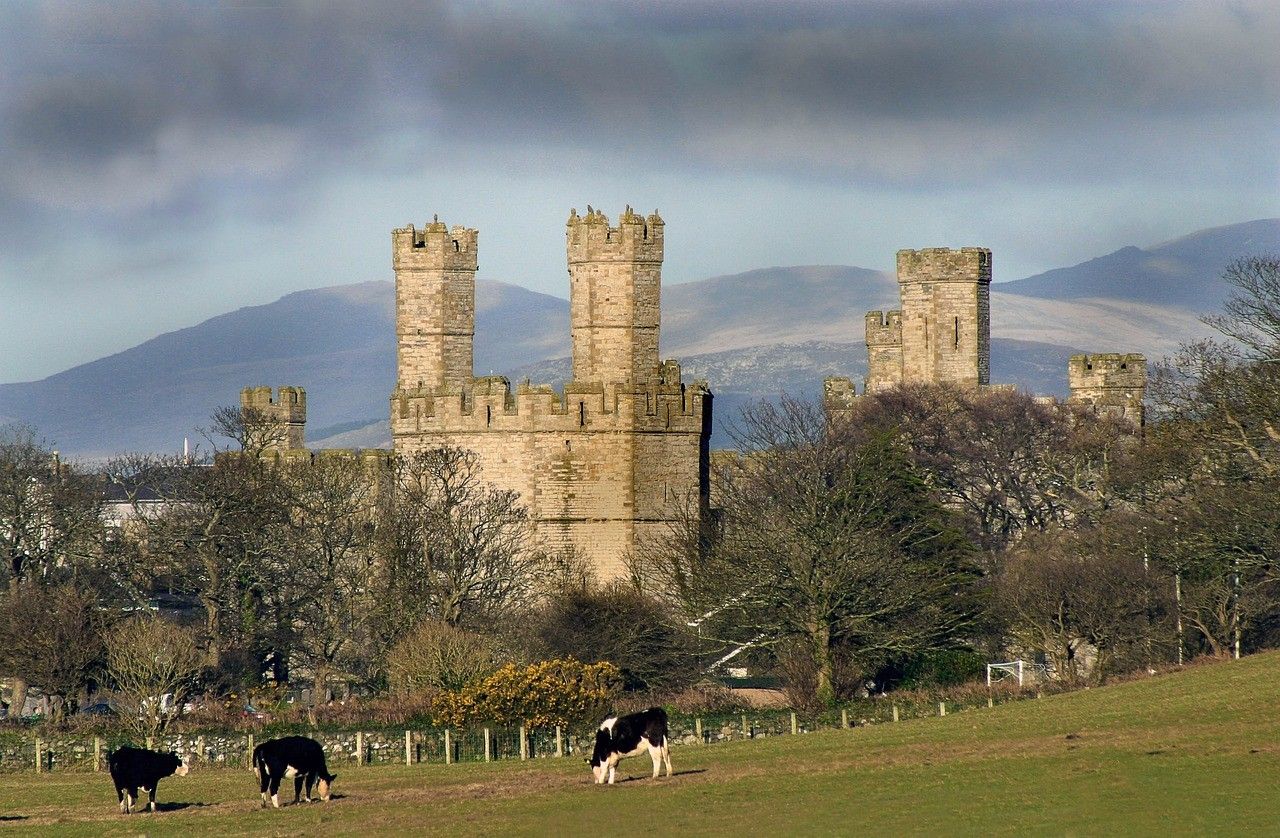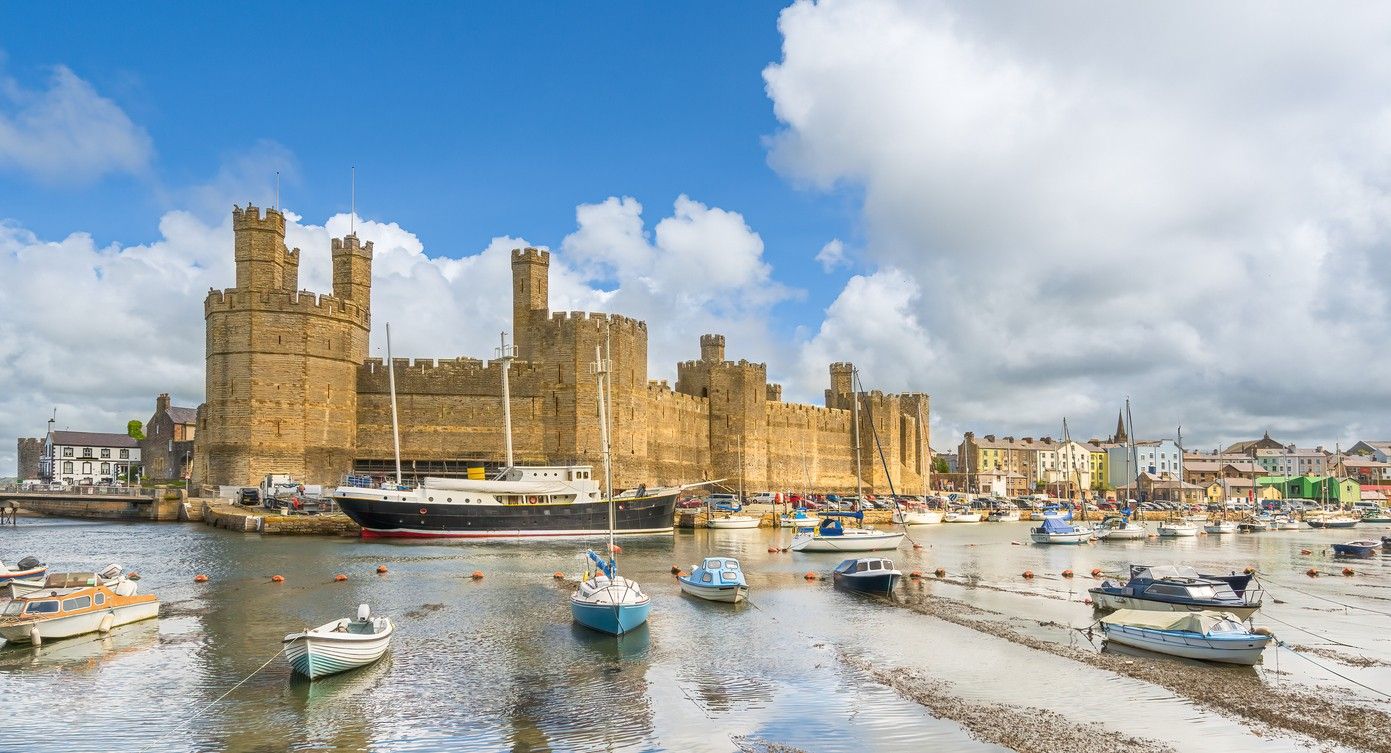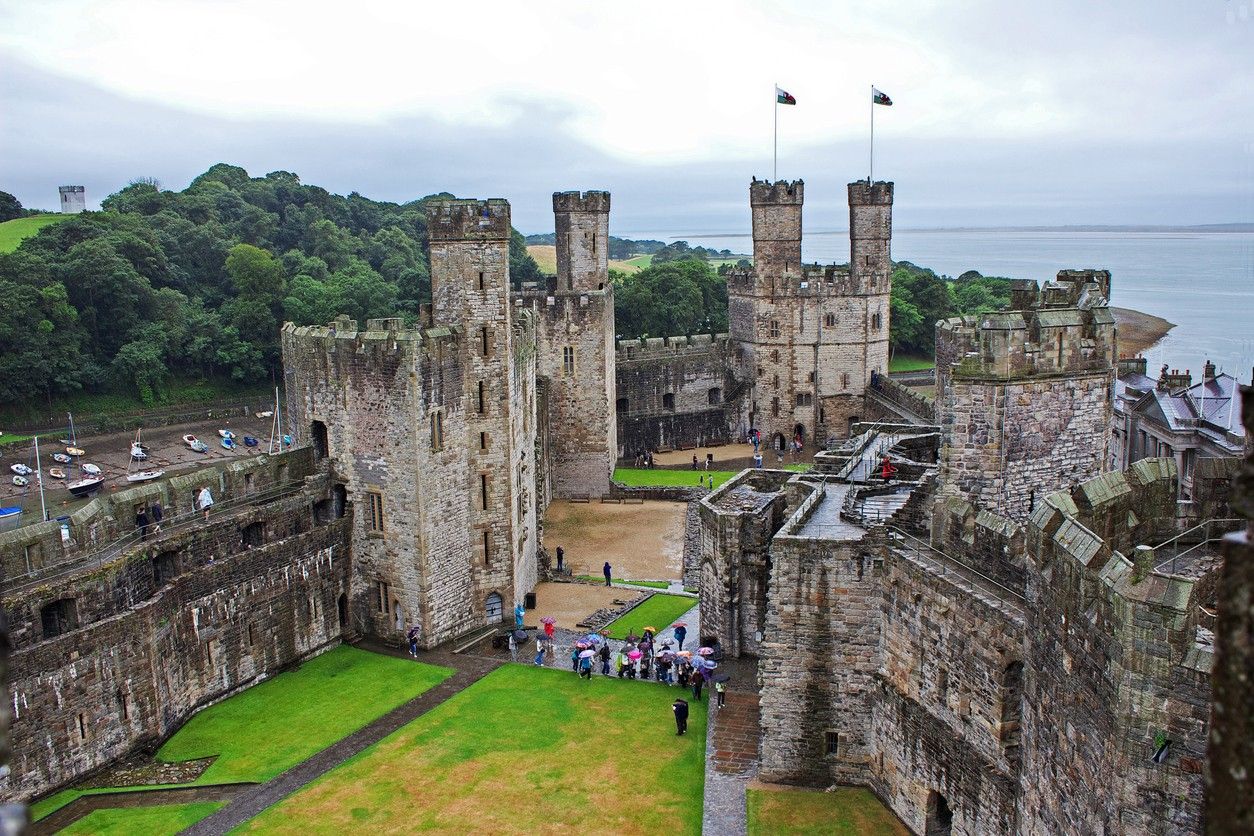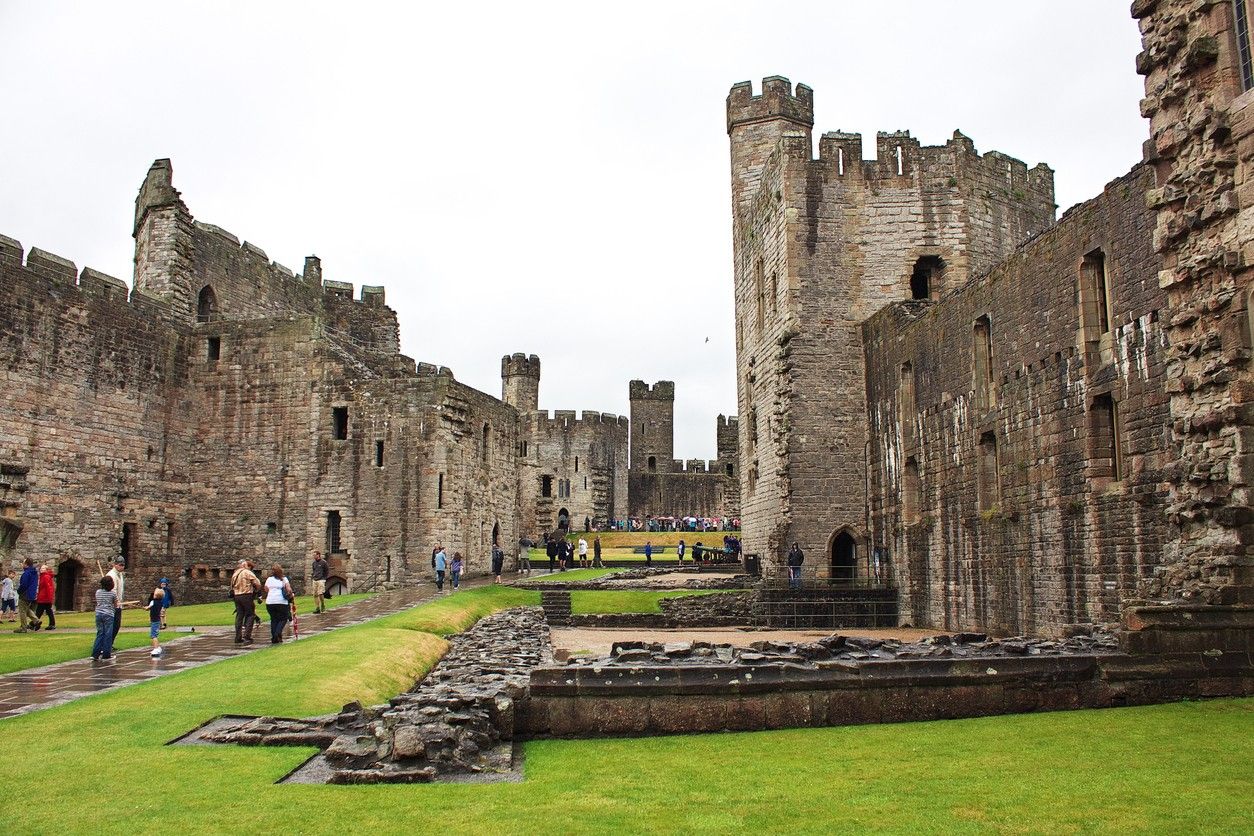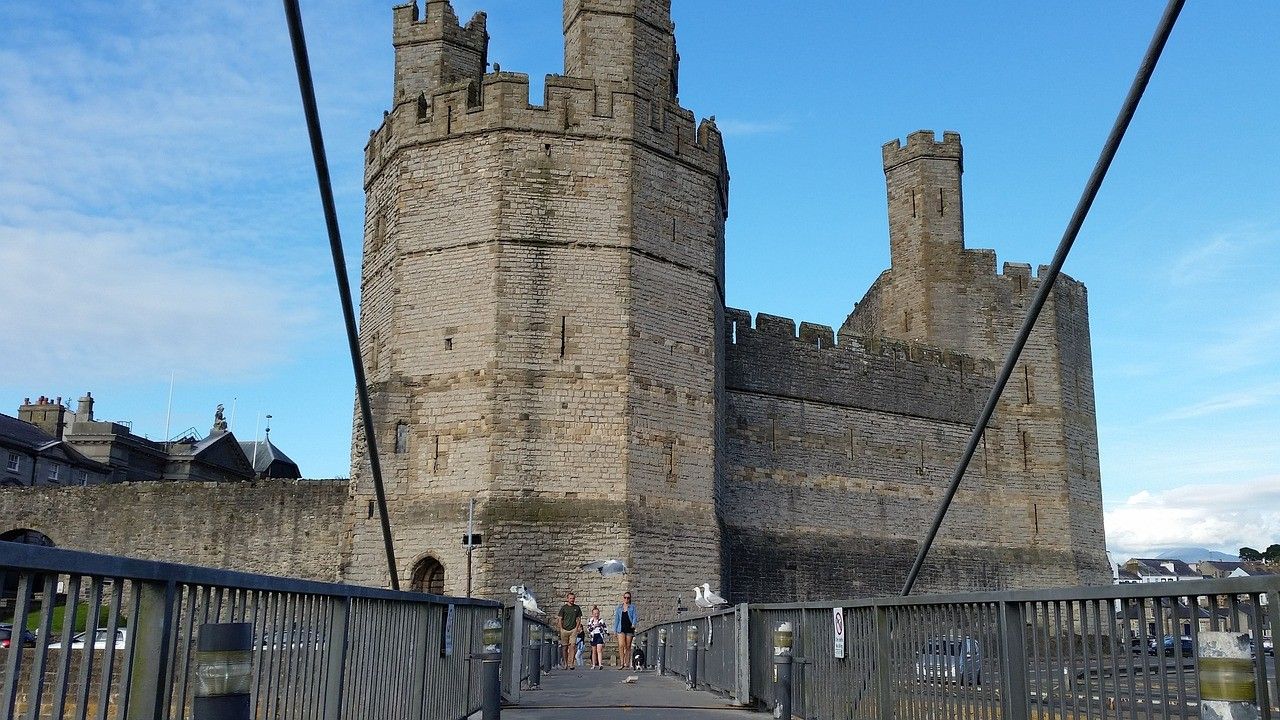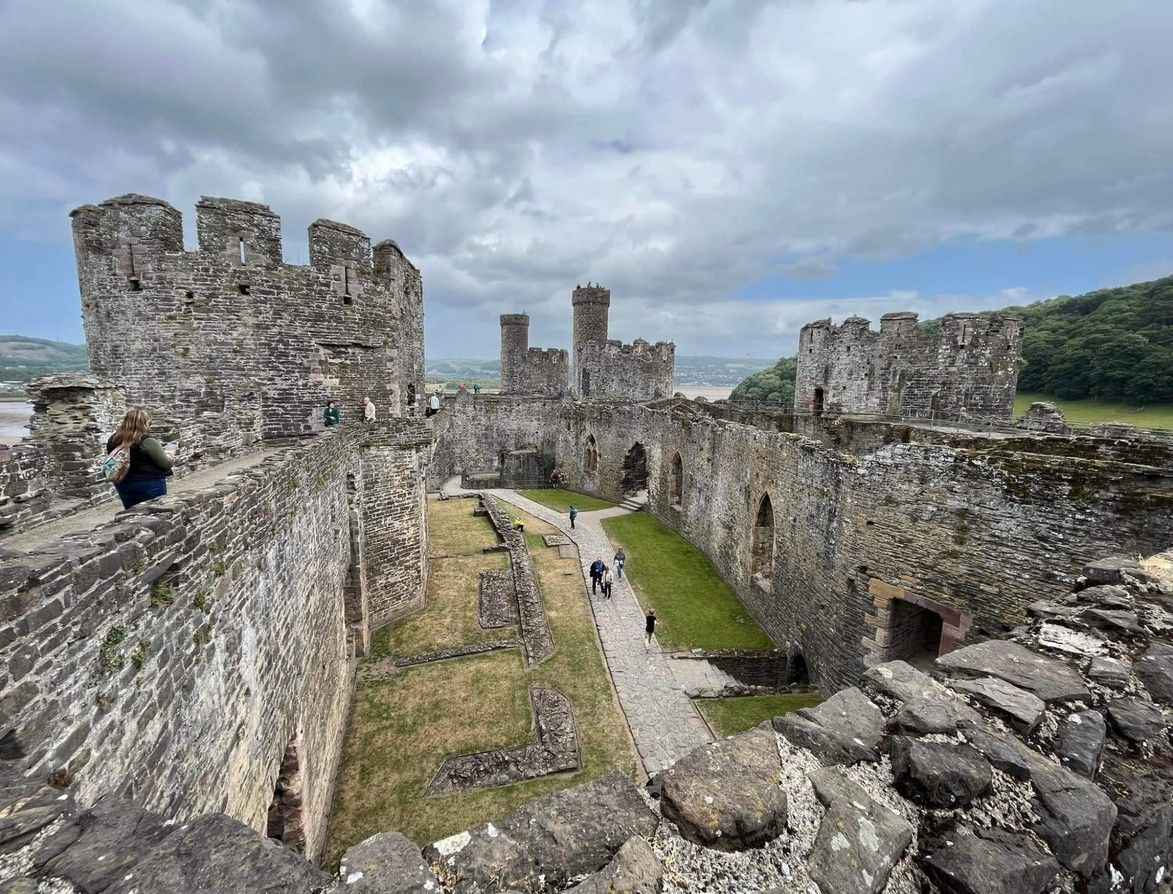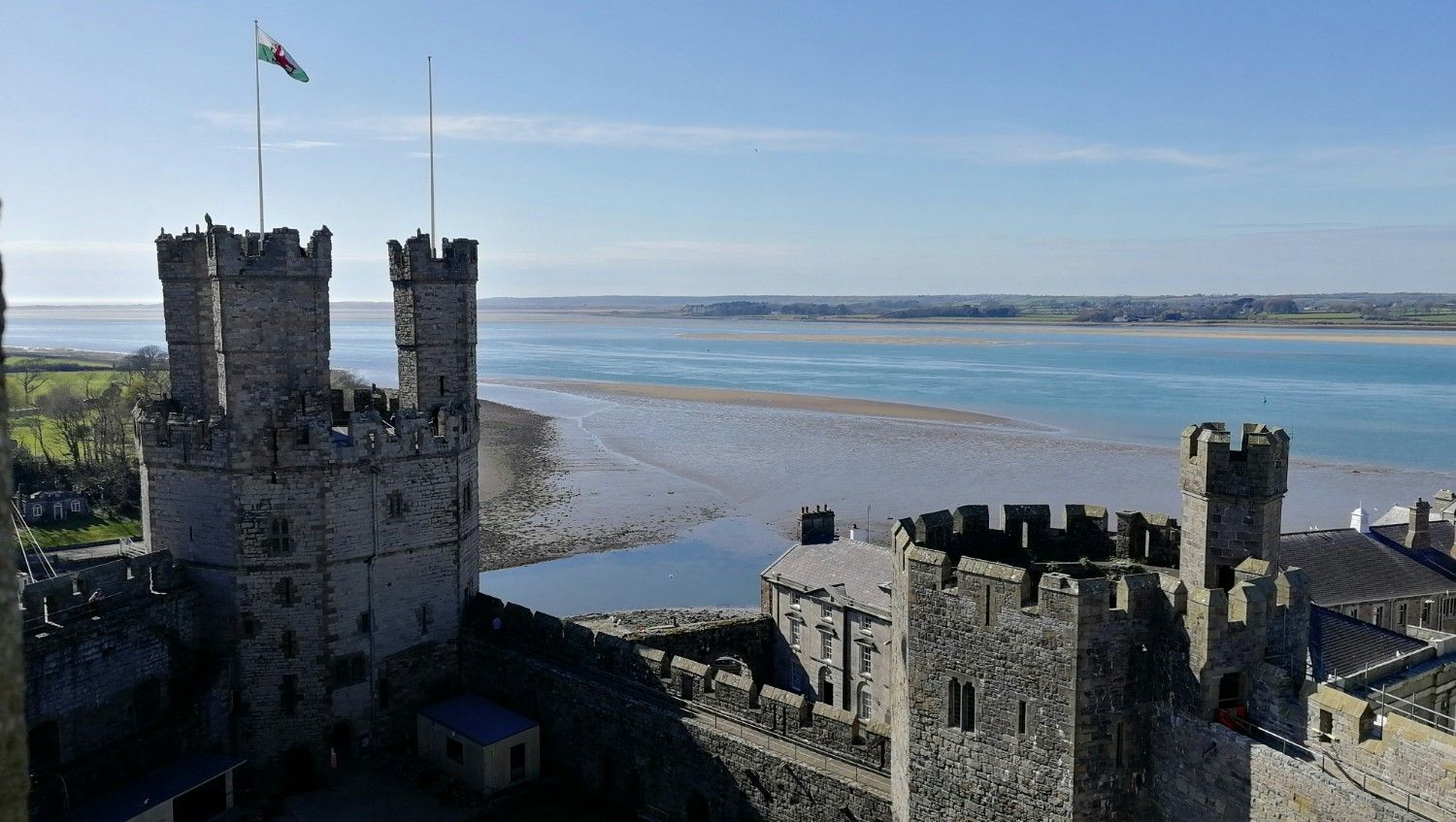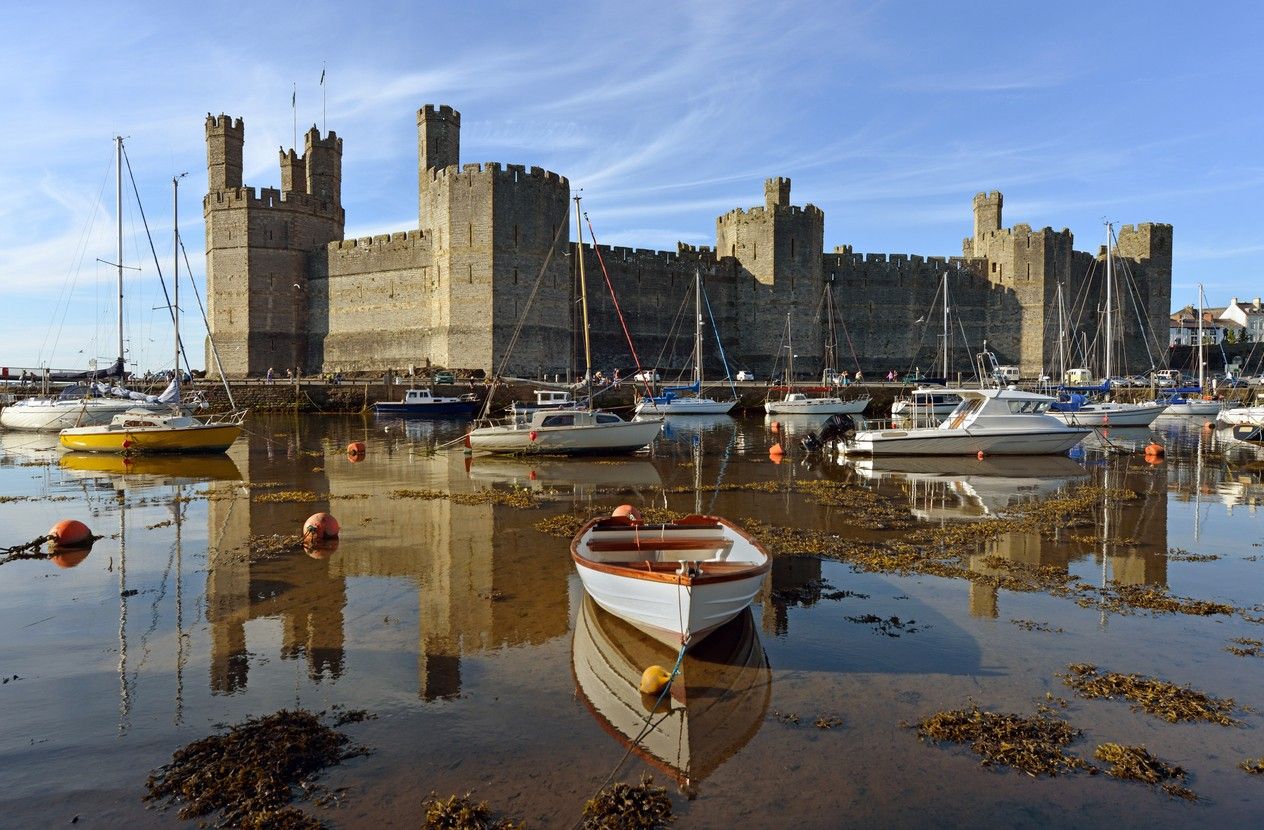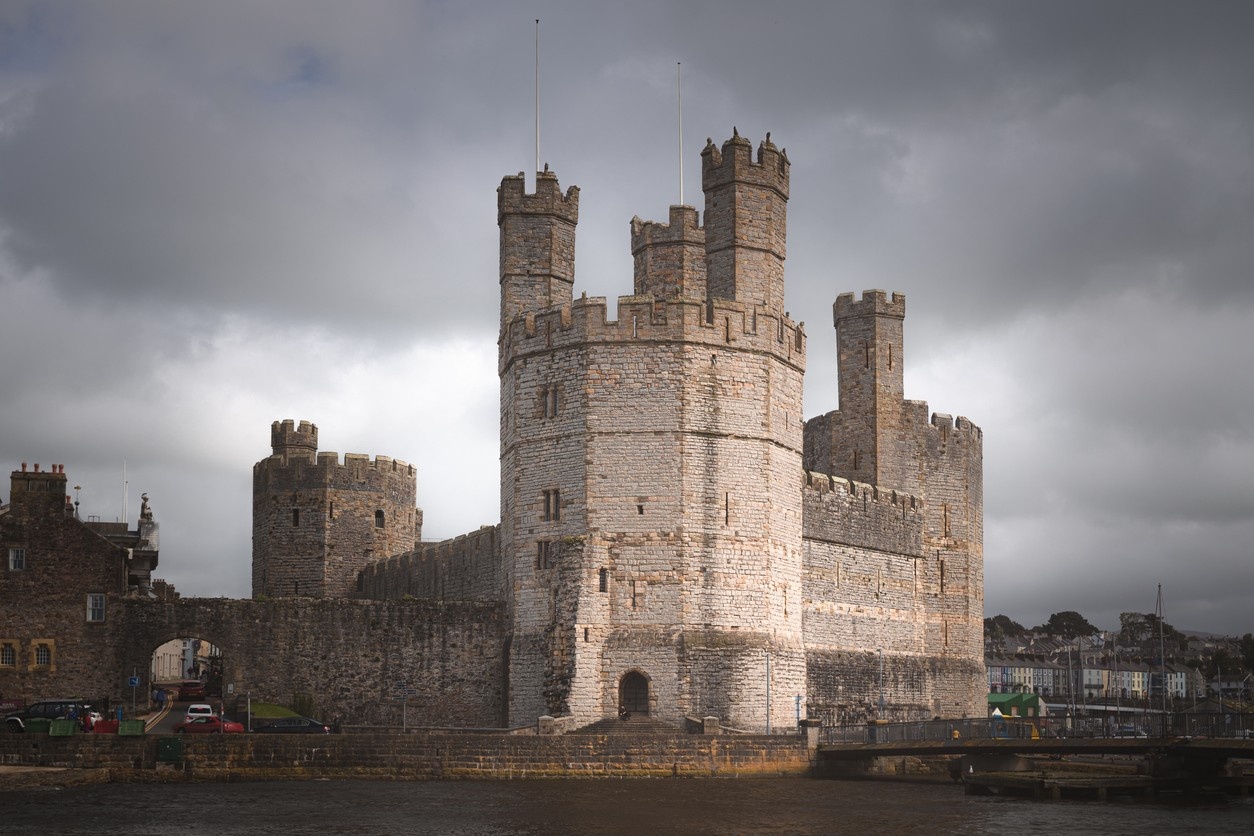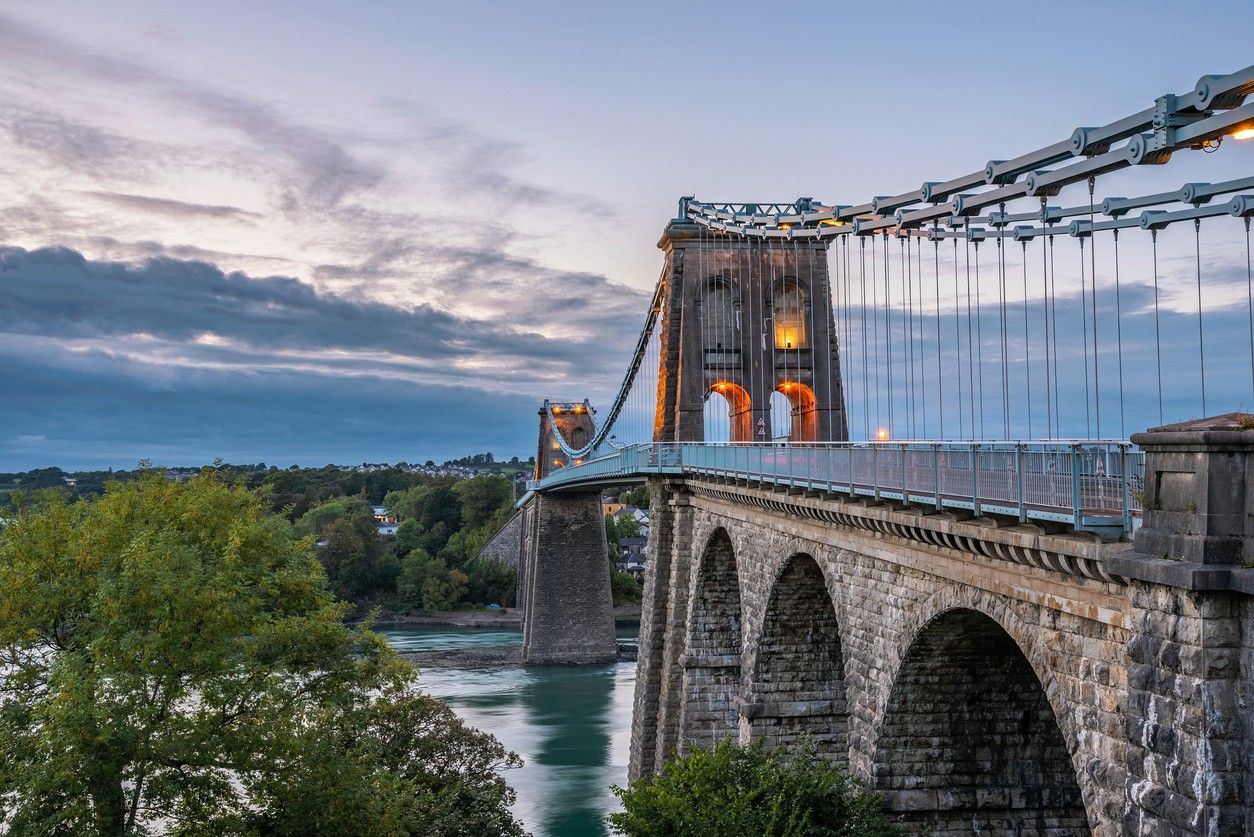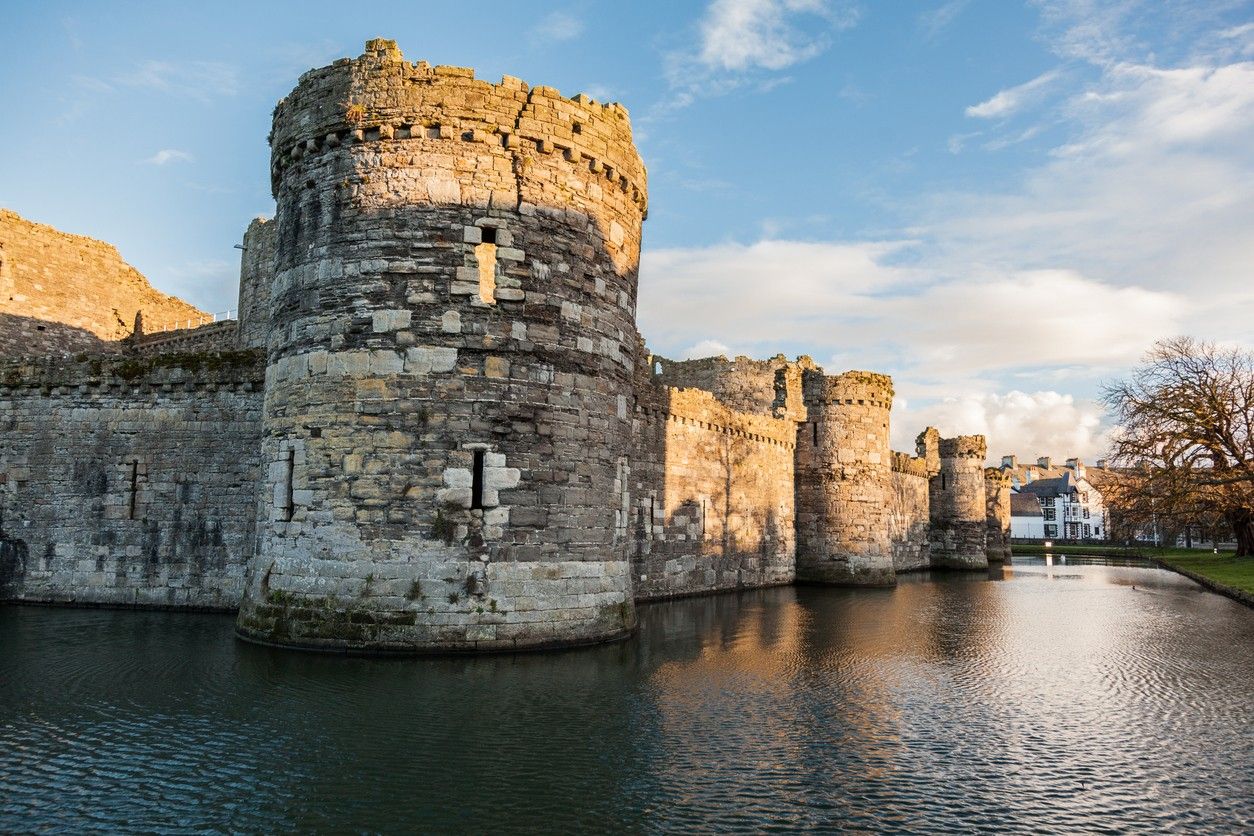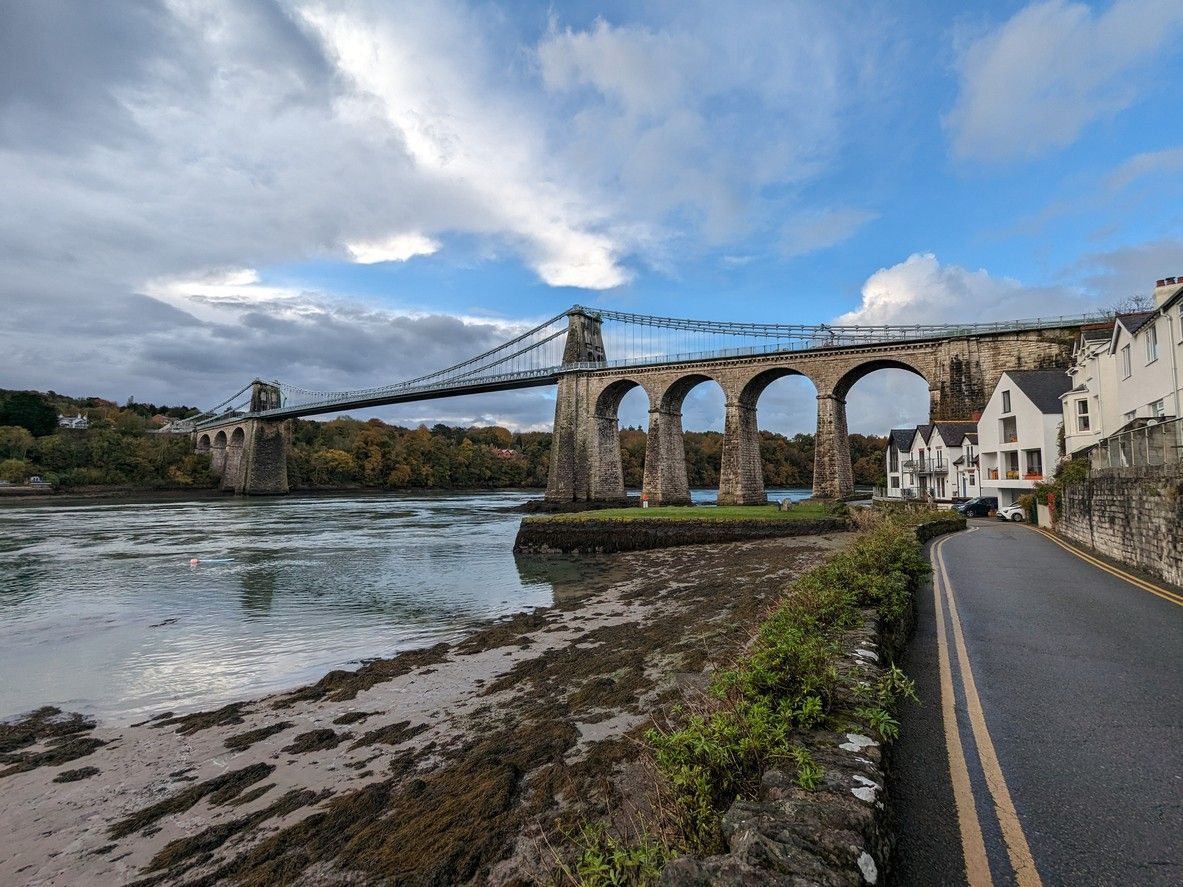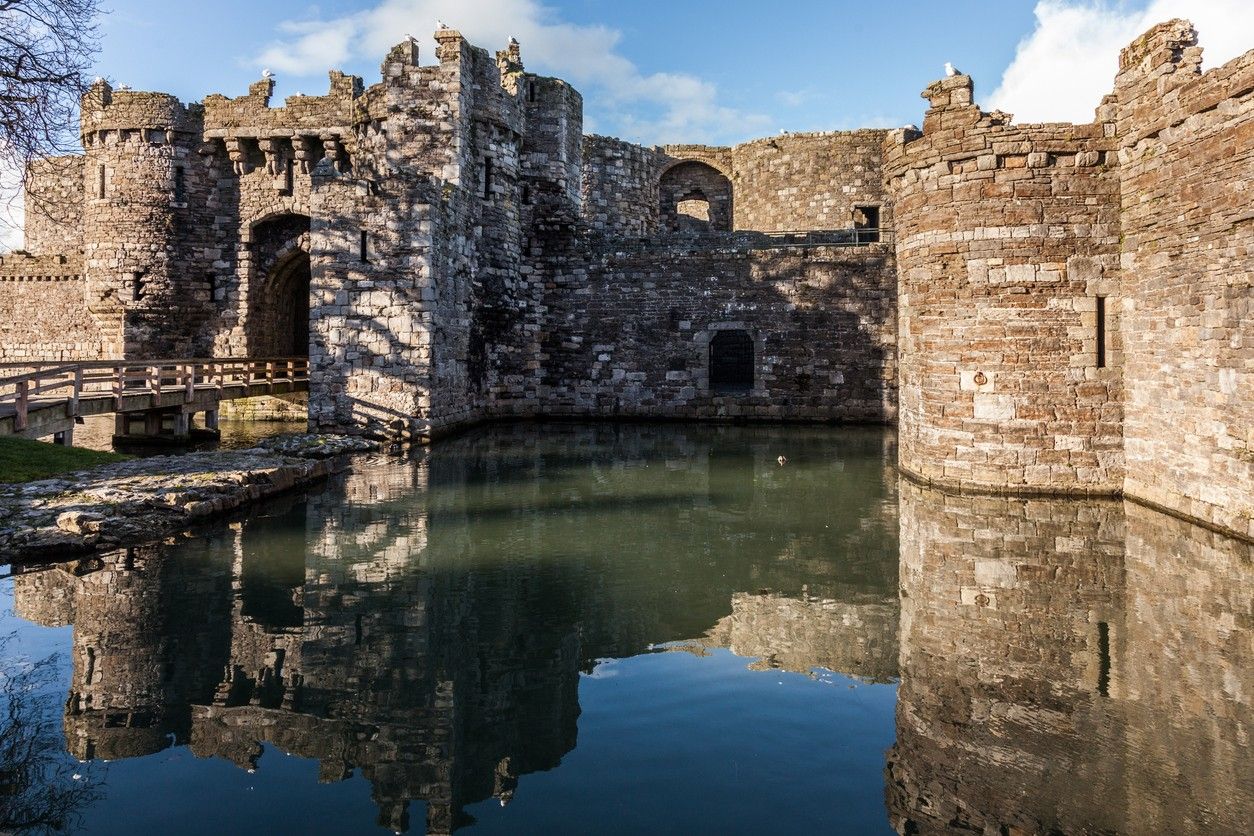Caernarfon Castle stands as a testament to the rich history and architectural prowess of Wales. This formidable fortress, located in the town of Caernarfon, has captured the imagination of visitors for centuries. Whether you're a history enthusiast, an architecture buff, or simply seeking a unique and captivating experience, Caernarfon Castle is a must-visit destination in North Wales. From its storied origins in the late 13th century to its evolution as a strategic military stronghold, Caernarfon Castle's history is a tapestry of grand ambitions, fierce conflicts, and enduring cultural significance. Commissioned by the powerful King Edward I of England, this impressive castle was constructed to assert English dominance over the native Welsh population, and its distinctive architectural features, such as the iconic Eagle Tower and the intricate banded masonry, bear witness to the engineering prowess and political machinations of its creators. Beyond its historical and architectural marvels, Caernarfon Castle is also situated in a breathtaking natural setting, surrounded by the stunning landscapes of Snowdonia and the Menai Strait. Visitors can immerse themselves in the castle's rich past by exploring its imposing walls, towers, and halls, while also taking in the captivating natural beauty that surrounds this iconic landmark.
The History & Origins of Caernarfon Castle
Caernarfon Castle has a long and storied history, with its origins dating back to the late 13th century. Commissioned by King Edward I of England, this impressive castle was constructed to assert English dominance over the native Welsh population. The strategic location of Caernarfon, situated at the mouth of the River Seiont, made it an ideal site for a fortified stronghold. The castle's design reflects the military and political ambitions of its creators. With its imposing polygonal shape, massive stone walls, and intricate towers, Caernarfon Castle was built to be a formidable defensive structure. The castle's distinctive appearance, with its distinctive banded masonry pattern, is a hallmark of the "Edwardian castles" – a series of fortifications constructed by King Edward I to solidify English control over Wales.
The Construction & Evolution of Caernarfon Castle
The construction of Caernarfon Castle was a monumental undertaking, requiring the labour of thousands of skilled stonemasons, carpenters, and other craftsmen. The project spanned several decades, with construction beginning in 1283 and continuing well into the 14th century, as successive English kings sought to solidify their control over the Welsh territories. The castle's architectural design evolved, with various additions and modifications made by subsequent rulers. This process of continuous development and enhancement is a testament to the enduring importance and strategic significance of Caernarfon Castle throughout its long history. The initial construction of the castle was overseen by Master James of St. George, a renowned architect and military engineer who had previously worked on other Edwardian castles in Wales. Under his direction, the castle's distinctive polygonal shape began to take form, with its massive stone walls and intricate towers rising from the banks of the River Seiont. One of the most notable features of Caernarfon Castle's early construction was the use of a technique known as "Edwardian banded masonry." This distinctive style, which features alternating bands of light and dark stone, was a hallmark of the castles built by King Edward I and was intended to showcase the power and wealth of the English crown.
As the construction progressed, the castle's design continued to evolve, with various additions and modifications made to enhance its defensive capabilities and accommodate the changing needs of its inhabitants. The construction of the impressive main gatehouse, with its twin towers and ornate decorations, was a particularly significant development, as it served as the castle's primary entrance and was designed to impress and intimidate visitors. Perhaps the most iconic addition to Caernarfon Castle's architecture was the construction of the Eagle Tower, a massive structure that dominates the castle's skyline. This imposing tower, with its distinctive conical roof and eagle-themed decorations, was built to serve as the castle's primary defence and a symbol of English power. The castle's interior also underwent a series of transformations over the centuries, as its use and function shifted to meet the demands of different eras. The impressive Great Hall, where the castle's inhabitants would have gathered for feasts and ceremonies, was a testament to the grandeur and opulence of the English court, while the castle's extensive system of walls and towers, with their intricate network of passages and staircases, showcased the ingenuity and skill of the castle's builders. Throughout the construction and evolution of Caernarfon Castle, the castle's strategic importance remained a constant driving force. As the English sought to assert their dominance over the Welsh, the castle's imposing architecture and formidable defences played a crucial role in deterring and repelling any challenges to their authority.
Caernarfon Castle's Strategic Importance
The strategic location of Caernarfon Castle was a key factor in its construction and ongoing significance. Situated at the mouth of the River Seiont, the castle commanded a prime position overlooking the surrounding landscape and the nearby Menai Strait. This strategic positioning allowed the castle's garrison to monitor and control the movement of ships and troops in the region, making it a crucial asset for the English crown. Throughout its history, Caernarfon Castle played a vital role in the ongoing conflicts between the English and Welsh. The castle served as a base of operations for English forces, and it was the site of several important battles and sieges over the centuries. The castle's imposing defences and strategic location made it a formidable obstacle for any would-be invaders, and it remains a symbol of English dominance in the region. The castle's position at the mouth of the River Seiont was of particular strategic importance, as it allowed the English to maintain control over the sea routes and maritime trade in the region. The Menai Strait, which separates the island of Anglesey from the Welsh mainland, was a critical waterway for both commercial and military operations, and the castle's ability to monitor and defend this passage was a key factor in its strategic value.
In addition to its maritime influence, Caernarfon Castle also played a crucial role in the overland movement of troops and supplies. The castle's location on the Welsh mainland, with its proximity to the mountainous regions of Snowdonia, made it a natural staging ground for military campaigns against the native Welsh population. The castle's extensive system of walls, towers, and gatehouses allowed its garrison to project power and defend against any attempts at infiltration or siege. The castle's strategic significance was further enhanced by its connections to the broader network of Edwardian castles that were constructed throughout Wales in the late 13th and early 14th centuries. These formidable fortresses, which included such landmarks as Conwy Castle, Harlech Castle, and Beaumaris Castle, formed a coordinated system of defensive structures that allowed the English to maintain a firm grip on the Welsh territories. By controlling key strategic locations like Caernarfon Castle, the English were able to monitor the movement of people and goods, collect taxes and customs duties, and suppress any attempts at Welsh independence or rebellion. The castle's role as a symbol of English power and a hub of military and administrative activity made it a constant target for Welsh resistance forces, leading to a series of battles and sieges that have become pivotal moments in the history of the region.
Architectural Marvels of Caernarfon Castle
The architectural design of Caernarfon Castle is a captivating blend of functionality and artistic expression. The castle's polygonal shape, a departure from the traditional square or rectangular structures, was a strategic choice that increased its defensive capabilities. The towering walls, measuring up to 3 meters thick in some areas, were constructed using local stone and designed to withstand the most formidable of sieges. One of the castle's most striking features is the series of imposing towers that punctuate its perimeter. These towers, each with its distinct character, were not only practical, serving as lookout points and defensive positions, but also showcased the ingenuity and craftsmanship of the castle's builders. The design of the towers at Caernarfon Castle is a testament to the castle's architectural sophistication. Each tower features a unique shape and architectural detailing, creating a visually stunning and harmonious ensemble. The towers' strategic placement along the castle's walls allowed for comprehensive surveillance of the surrounding area, ensuring that the castle's defenders could quickly respond to any potential threats.
In addition to the impressive towers, the castle's interior spaces also display a remarkable level of architectural finesse. The Great Hall, for instance, is a masterpiece of medieval engineering, with its soaring ceilings and grand proportions creating a sense of grandeur and power. The intricate stone carvings and decorative elements that adorn the castle's walls and halls further highlight the skill and artistry of the castle's builders. Visitors can explore the castle's architectural marvels by navigating through its various walkways and staircases, each offering a unique perspective on the castle's design and construction.
The Legends & Lore of Caernarfon Castle
Alongside its rich historical significance, Caernarfon Castle is also shrouded in a veil of mystery and legend. The castle's long and tumultuous past has given rise to numerous tales and stories that have captivated visitors for generations.
The Ghostly Presence of the "Green Lady"
One of the most captivating and enduring legends surrounding Caernarfon Castle is the tale of the "Green Lady," a mysterious and ethereal figure said to haunt the castle's corridors. This ghostly presence has captured the imaginations of visitors for generations, adding an eerie and supernatural element to the castle's already rich history. According to the legend, the Green Lady is the spirit of a young woman who met a tragic end within the castle's walls. The details of her story vary, but many accounts suggest that she was a former resident of the castle, perhaps a lady-in-waiting or a noblewoman, who was imprisoned or met her demise under mysterious circumstances.
Some versions of the legend claim that the Green Lady was a woman who fell in love with a forbidden suitor, only to be discovered and condemned by the castle's powerful occupants. Others suggest that she was a victim of political intrigue, caught up in the web of power struggles and betrayals that often plagued medieval fortresses like Caernarfon. Regardless of the specifics, the legend holds that the Green Lady's spirit was unable to find rest, and she now forever haunts the castle, her ghostly form drifting through the shadows and corridors. Witnesses have reported seeing a pale, ethereal figure shrouded in a green mist, her footsteps echoing through the empty halls and her sorrowful cries echoing in the night. The enduring power of the Green Lady legend lies in its ability to tap into our collective fascination with the supernatural and the unknown. The idea of a restless spirit, doomed to wander the halls of the castle for eternity, speaks to our deep-seated fears and curiosities about the afterlife and the mysteries that lie beyond the veil of the mortal world.
The Arthurian Connection
In addition to the haunting legend of the Green Lady, Caernarfon Castle is also steeped in connections to the mythical figure of King Arthur, further adding to the castle's air of mystery and intrigue. According to some accounts, the site upon which Caernarfon Castle was built has long been associated with the Arthurian legend. The castle is said to have been constructed on the ruins of an earlier Roman fort that may have had connections to the legendary king and his knights. This Arthurian link is further bolstered by the castle's location, which sits on the banks of the Menai Strait, a body of water that has long been associated with the mythical Isle of Avalon – the legendary resting place of King Arthur after his final battle. The castle's strategic position, overlooking the narrow waterway, has led some scholars to suggest that it may have been built to guard a site of great significance in the Arthurian mythos.
Moreover, the castle's distinctive polygonal design has been interpreted by some as a nod to the legendary Round Table, the fabled gathering place of Arthur and his knights. The castle's unique shape, with its multiple towers and defensive structures, has been seen by some as a physical manifestation of the mythical roundtable, further cementing its connection to the Arthurian legend. These tantalising links between Caernarfon Castle and the world of King Arthur have captivated visitors for centuries, sparking their imagination and inviting them to delve deeper into the castle's rich tapestry of legends and lore. The castle's Arthurian connections add an extra layer of mystery and intrigue to its already captivating history, drawing in those who are fascinated by the enduring power of myth and legend.
Tales of Treachery and Betrayal
While the ghostly presence of the Green Lady and the Arthurian connections have captured the public's imagination, Caernarfon Castle's storied past is also marked by darker tales of treachery, betrayal, and political intrigue – events that have left an indelible mark on the castle's history. Many of these stories are inextricably linked to the castle's role as a strategic stronghold in the ongoing power struggles between the English and Welsh kingdoms. As a symbol of English dominance over the region, Caernarfon Castle was a frequent target of Welsh rebellions and uprisings, with its walls bearing witness to countless acts of violence and betrayal. One of the most notorious events in the castle's history was the execution of Dafydd ap Gruffydd, the last native Prince of Wales, in 1283. Dafydd had led a failed uprising against the English crown, and his gruesome punishment – he was hanged, drawn, and quartered – sent a chilling message about the consequences of defying the king's authority.
Tales of royal rivalries and political intrigue also abound within the castle's walls. The castle was a frequent residence of the English monarchs, and it played a central role in the complex power dynamics of the medieval era. Stories of court betrayals, palace coups, and bloody power struggles have been passed down through the generations, adding to the castle's aura of drama and high-stakes drama. These dark and disturbing tales of treachery and betrayal serve as a sobering counterpoint to the castle's more fantastical legends, reminding visitors of the harsh realities of life in the Middle Ages. They also underscore the castle's pivotal role in the ongoing struggle for power and self-determination in the region, a conflict that has left an indelible mark on the castle's history and the collective memory of the Welsh people.
Accommodations & Dining Options near Caernarfon Castle
For those looking to fully immerse themselves in the captivating world of Caernarfon Castle, the surrounding area offers a wealth of accommodations and dining options to enhance your visit.
Accommodations
Visitors to Caernarfon Castle have a variety of accommodation options to choose from, ranging from charming bed and breakfasts to cosy holiday cottages and modern hotels. Many of these establishments are located just a short distance from the castle, providing easy access for exploring the historic site.
The Castle Hotel — A historic inn located just a 2-minute walk from the castle, offering comfortable rooms and stunning views of the castle's walls.
Ty Castell Bed & Breakfast — A charming B&B situated a 5-minute stroll from the castle, providing a warm Welsh welcome and a cosy home-like atmosphere.
Caernarfon Bay Holiday Cottages — Situated just a 10-minute drive from the castle, these self-catering cottages offer a peaceful retreat with easy access to the historic site.
The Black Boy Inn — A traditional Welsh inn located a 3-minute walk from the castle, featuring comfortable guest rooms and a lively pub atmosphere.
Tŷ Glyndŵr Boutique Hotel — A stylish boutique hotel just a 7-minute walk from the castle, offering modern amenities and exceptional service.
Dining Options
After a day of exploring the castle, visitors can indulge in the local culinary delights and vibrant pub culture. The town of Caernarfon is home to a variety of restaurants and eateries, many of which showcase the best of Welsh cuisine, from traditional dishes like Cawl (a hearty lamb stew) to modern interpretations of Welsh classics.
Owain Glyndŵr Restaurant — Located within the castle grounds, this restaurant offers panoramic views of the castle and serves up delectable Welsh cuisine.
The Anglesey Arms — A popular Caernarfon Castle pub situated a 2-minute walk from the castle, known for its extensive selection of local ales and traditional Welsh dishes.
Blas Restaurant — A fine-dining establishment located a 5-minute walk from the castle, specialising in contemporary Welsh fare with a focus on locally sourced ingredients.
Y Gegin Fach — A cosy, family-run café just a 4-minute walk from the castle, serving up homemade Welsh cakes, soups, and light bites.
The Waterfront Restaurant — Situated along the Caernarfon Marina, a 10-minute walk from the castle, this restaurant offers stunning views and a menu showcasing the best of local seafood.
Attractions & Places to Visit Near Caernarfon Castle
In addition to the captivating attractions within Caernarfon Castle itself, the surrounding area offers a wealth of additional experiences and destinations that complement a visit to this iconic landmark. From picturesque natural landscapes to charming historic towns, there is no shortage of ways to extend your exploration of North Wales.
Outdoor Activities & Places To Visit
Conwy Castle — A UNESCO World Heritage Site located just a 25-minute drive from Caernarfon Castle, this impressive medieval fortress is a must-visit for history enthusiasts.
Segontium Roman Fort — The ruins of this ancient Roman settlement, situated a 10-minute walk from Caernarfon Castle, provide a fascinating glimpse into the region's ancient past.
Caernarfon Town Walls — Visitors can stroll along the well-preserved town walls, just a stone's throw from Caernarfon Castle, for stunning views of the castle and the surrounding landscape.
Caernarfon Maritime Museum — This museum, located a 5-minute walk from the castle, showcases the town's rich maritime history and its connections to the sea.
Anrheg Gift Shop — A charming local gift shop situated next to the castle, offering a wide selection of Welsh-made souvenirs and handicrafts.
Snowdonia National Park
Just a short distance from Caernarfon Castle, the sprawling Snowdonia National Park is a must-visit destination for nature enthusiasts and outdoor adventurers. Encompassing over 800 square miles of rugged mountains, pristine lakes, and lush forests, this stunning landscape offers a wealth of hiking trails, scenic drives, and opportunities for activities such as rock climbing, mountain biking, and even zip-lining. One of the park's most iconic features is Mount Snowdon, the highest peak in Wales. Visitors can challenge themselves by scaling the mountain's trails, which offer a range of difficulty levels to suit hikers of all abilities. The journey to the summit is a true test of endurance, but the panoramic views from the top are truly breathtaking, offering a stunning panorama of the surrounding peaks and valleys.
The Snowdon Mountain Railway provides a scenic alternative. This historic railway, which has been in operation since 1896, carries passengers to the summit in comfort, allowing them to soak in the stunning vistas without the physical exertion of the hiking trails. Beyond Mount Snowdon, Snowdonia National Park is home to a wealth of other natural wonders, from the serene glacial lakes of the Llanberis Pass to the thundering waterfalls of the Ogwen Valley. Hikers can traverse the park's extensive network of trails, discovering picturesque villages, ancient monuments, and breathtaking viewpoints along the way.
The park's cultural heritage is just as captivating as its natural beauty. Visitors can explore the remnants of medieval castles, such as Dolwyddelan and Castell y Bere, or immerse themselves in the rich history and traditions of the Welsh people. The charming towns and villages scattered throughout the park, such as Betws-y-Coed and Beddgelert, offer a glimpse into the region's vibrant cultural tapestry, with their quaint streets, local artisans, and traditional pubs. Snowdonia National Park is a premier destination for outdoor activities like rock climbing, mountain biking, and even zip-lining. Adventure seekers can test their skills on the park's rugged terrain, soaring through the air or scaling the sheer rock faces for a truly exhilarating encounter with the natural world.
Menai Suspension Bridge
Another must-see attraction near Caernarfon Castle is the iconic Menai Suspension Bridge, which spans the Menai Strait between the island of Anglesey and the Welsh mainland. Designed by the renowned engineer Thomas Telford, this 19th-century masterpiece of engineering is a true architectural marvel, featuring a graceful suspension design that has become a symbol of the region. Completed in 1826, the Menai Suspension Bridge was a groundbreaking achievement in its time, as it was the first modern suspension bridge to be built for road traffic. Telford's design, which features two massive stone towers supporting a suspended deck, was a testament to his engineering prowess and the ingenuity of the Victorian era. Crossing the Menai Suspension Bridge is a truly exhilarating experience. The deck of the bridge, which stretches nearly 1,000 feet in length, sways gently in the wind, offering breathtaking views of the surrounding landscape. Visitors can pause midway to take in the panoramic vistas, which include the rugged shoreline of Anglesey, the distant peaks of Snowdonia, and the sparkling waters of the Menai Strait. Beyond its architectural significance, the Menai Suspension Bridge has also played a crucial role in the history and development of the region. Before its construction, the only way to cross the Menai Strait was by ferry, a time-consuming and often treacherous endeavour. The bridge's completion revolutionised transportation in the area, making it easier for people and goods to move between the mainland and the island of Anglesey.
Beaumaris Castle
Just a short distance from Caernarfon Castle, the impressive Beaumaris Castle is another must-visit destination for history enthusiasts and architecture lovers. Constructed in the late 13th century by King Edward I, this UNESCO World Heritage Site is considered one of the most architecturally sophisticated castles in the world, with its concentric design and meticulously crafted stone walls. Beaumaris Castle was the last of the "English castles" built by King Edward I to consolidate his conquest of Wales, and it is widely regarded as the most technically perfect example of a concentric castle design. This innovative approach to castle architecture, with its multiple layers of defensive walls and towers, was a response to the growing threat posed by advanced siege weapons and evolving military strategies. The castle's imposing outer walls, measuring over 30 feet in height, are punctuated by a series of towers and gatehouses, creating a formidable and impregnable fortress. The inner bailey, accessible through the main gatehouse, is a testament to the castle's architectural sophistication, with its elegant proportions and intricate decorative elements.
One of the most impressive features of Beaumaris Castle is its concentric design, with a series of nested walls and towers that provide multiple layers of defence. This innovative approach, which was a departure from the traditional "motte and bailey" castle design, allowed the garrison to better withstand sieges and maintain control over the surrounding region. Visitors to Beaumaris Castle can explore a wealth of fascinating historical details and architectural marvels. They can climb to the top of the castle's towers for panoramic views of the surrounding landscape, including the Menai Strait and the distant peaks of Snowdonia. The castle's interactive exhibits and guided tours provide a wealth of information about its construction, the lives of its inhabitants, and its role in the ongoing conflicts between the English and Welsh. Beyond its architectural and historical significance, Beaumaris Castle is also situated in a stunning natural setting, with the Menai Strait and the Irish Sea as its backdrop. Visitors can stroll along the castle's perimeter walls, taking in the breathtaking views and soaking in the serene atmosphere of the surrounding area. With its impressive concentric design, its captivating historical narrative, and its stunning natural setting, this UNESCO World Heritage Site is a true gem that is sure to leave a lasting impression on all who visit.
Planning Your Visit to Caernarfon Castle
Visiting Caernarfon Castle is a must-do for anyone exploring the rich history and culture of North Wales. Here are some practical tips and information to help you plan your visit:
Location and Accessibility — Caernarfon Castle is located in the town of Caernarfon, in the county of Gwynedd, North Wales. The castle is situated at the mouth of the River Seiont, overlooking the Menai Strait and the mountains of Snowdonia. The castle is easily accessible by car, with ample parking available nearby. Visitors can also reach the castle by public transportation, with regular bus and train services connecting Caernarfon to surrounding towns and cities.
Opening Hours and Admission — Caernarfon Castle is open to visitors all year round, except for a few major holidays. The castle's opening hours vary by season, with extended hours during the peak summer months. Admission to the castle is charged, with discounted rates available for seniors, students, and children. Visitors can purchase tickets on-site or online in advance to skip the queues.
Guided Tours and Audio Guides — Visitors to Caernarfon Castle can enhance their experience by taking advantage of the castle's guided tours and audio guides. Guided tours are available throughout the day and offer a deeper insight into the castle's history and architecture. Audio guides are also available, providing a self-guided tour with informative commentary in multiple languages.
Accessibility and Family-Friendly — Caernarfon Castle is generally accessible to visitors with mobility challenges, with ramps and designated parking available. The castle also offers a range of family-friendly features, including interactive exhibits and activities designed to engage children and keep them entertained during their visit.
Caernarfon Castle Tickets — Visitors can purchase Caernarfon Castle tickets on-site or online in advance to avoid long queues. The castle offers a range of ticket options, including adult and child admission, as well as discounted rates for students, seniors, and families.
Caernarfon Castle Pub — After exploring the castle, visitors can take a break and enjoy the local hospitality at one of the charming Caernarfon Castle pubs in the town. These establishments offer a warm and welcoming atmosphere, along with a range of traditional Welsh cuisine and beverages.
Related Articles

Let us know you agree to cookies
We use marketing, analytical and functional cookies as well as similar technologies to give you the best experience. Third parties, including social media platforms, often place tracking cookies on our site to show you personalised adverts outside of our website.
We store your cookie preferences for two years and you can edit your preferences via ‘manage cookies’ or through the cookie policy at the bottom of every page. For more information, please see our cookie policy.

